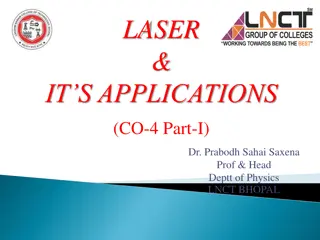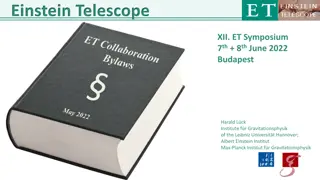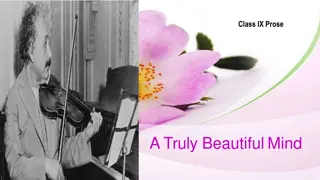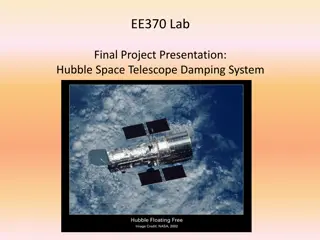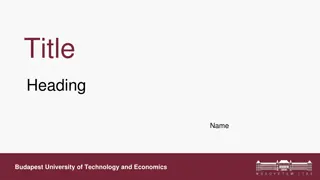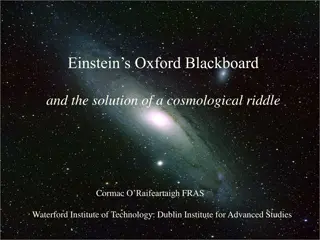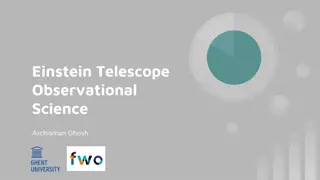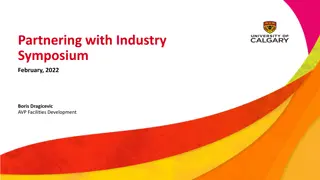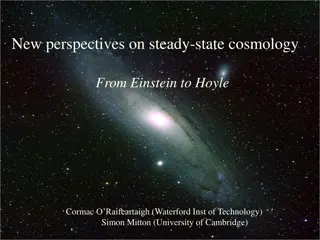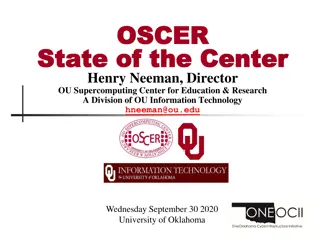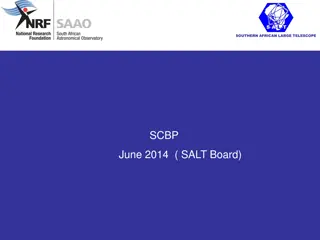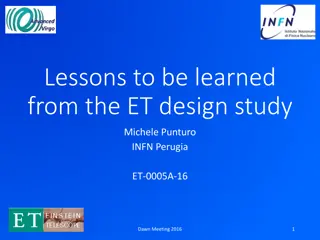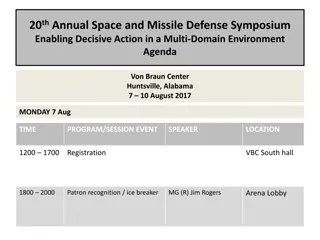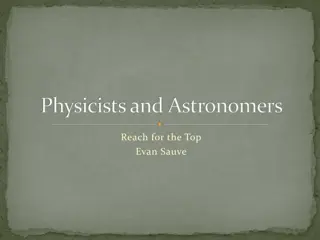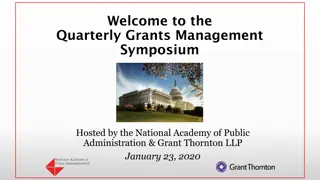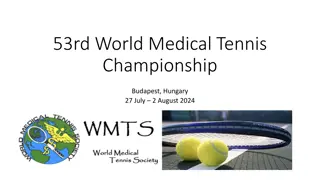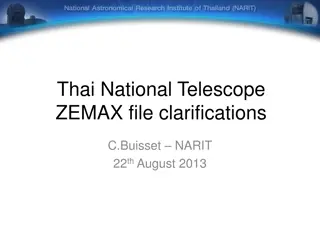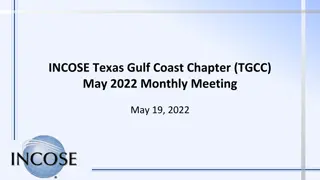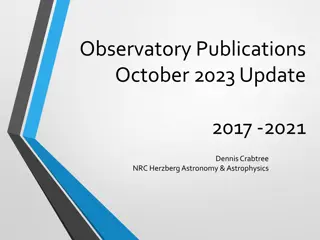Einstein Telescope Collaboration Board Symposium 2022 Budapest Agenda and Special Guests
The Einstein Telescope Collaboration Board Symposium 2022 in Budapest covers various agenda items including membership, elections, discussions on boards, and updating Bylaws. Special guests from ET Directorate and other collaborations are attending. The Collaboration Board is the governing body making important decisions for the Collaboration.
Download Presentation

Please find below an Image/Link to download the presentation.
The content on the website is provided AS IS for your information and personal use only. It may not be sold, licensed, or shared on other websites without obtaining consent from the author.If you encounter any issues during the download, it is possible that the publisher has removed the file from their server.
You are allowed to download the files provided on this website for personal or commercial use, subject to the condition that they are used lawfully. All files are the property of their respective owners.
The content on the website is provided AS IS for your information and personal use only. It may not be sold, licensed, or shared on other websites without obtaining consent from the author.
E N D
Presentation Transcript
Einstein Telescope Collaboration Board ET Symposium 2022 Budapest
Agenda 1) Welcome / Quorum (>30%?) 2) Mandate of the Collaboration Board 3) Members of the Collaboration Board and additional observers i) accepted RUs ii) excluded RUs iii) RU Proposals to be evaluated 4) Preparations for upcoming elections and votes. i) Nominations for CB Chair 5) Discussion on boards and committees to be formed. 6) Process for updating the Bylaws 7) Meeting Cadence and next meeting
Special Guests today The ET Directorate: Fernando Ferroni, Jo v.d. Brand Other collaborations: D. Shoemaker represents both CE and LIGO. Jun'ichi Yokoyama for KAGRA Giovanni Losurdo for Virgo. Applicants for RU, which could not be accepted yet: John Antoniadis, Institute of Astrophysics, Greek Foundation for Research and Technology, Heraklion Greece Robert Kovacs, Budapest University of Technology and Economics, Budapest, Hungary
Collaboration Board (CB) The ET Collaboration Board is the representative and governing body of the Collaboration. Its decisions on matters of science, policy, and procedure are binding and represent the position of the Collaboration. The CB: elects the Spokesperson (SP) and the Deputy Spokesperson (DSP) for a three-year term. elaborates ET's long-term strategy and recommends it to the stakeholders. approves and revises the Collaboration Bylaws. defines the membership rules for the ET collaboration. defines the publication rules for the collaboration. decides on the inclusion of new Research Units in the ET collaboration approves the main responsibilities and expenditures suggested by the EB and communicates them to the Council. proposes the relations with other scientific collaborations and projects for endorsement by the Project Directorate. has the duty of verifying the actual full-research-time equivalent (FRTE) elects its Chair for a three-year term by simple majority. approves the members and the structure of the Executive Board (EB) proposed by the Spokesperson. elects chairs of the Specific Boards and panels by simple majority. These chairs will be ex officio members of the EB. Specific Boards and Committees are proposed by the Spokesperson and voted into existence (or termination) by the CB, in an action that modifies the Bylaws. The delegate/s on the CB of each RU has/have the responsibility to declare the FRTE composition of the RU. The Chair coordinates the work of the CB, calls for meetings of the CB that should take place at least two times a year. In the start-up phase: The present chairs of the specific boards keep their role until the end of their mandate
Collaboration Board Composition Each Research Unit contributing more than 2 FRTE to the ET Collaboration, is represented in the CB by at least one delegate. Number of delegates per RU = int(1 + nFRTE/m) if nFRTE >= 2; m = 5 1 delegate per RU in the first year! CB may admit (and exclude) observers without voting rights from external projects to the meetings. In this case, the CB should try to agree on reciprocity with the other projects. The Project Directors are invited to CB meetings as observers (TBC) CB members have a responsibility to actively participate in the CB's governance process, including staying informed of CB business, discussing CB issues with their respective Research Units, representing their RU s perspective in the CB, and participating in CB decision-making; if this is not possible, a different delegate should be designated.
Collaboration Board Composition ctnd. ET Collaboration Proxies: If a member of the Collaboration Board is unable to attend an important meeting, he/she may send a proxy to attend in his/her place. This possibility is limited to exceptional cases and requires the consent of the CB chair. FNR Policy proposals+ monitoring CB EB Collaboration Board Executive Board Informing managing reporting managing SSB SF reporting managing Services and Standards Board Science Forum In some cases due to a misunderstanding in the creation of the mailing list, submitters instead of RU leaders have been invited to this meeting. I d like to ask you to accept them as proxies for the RU leaders for this meeting. Providing services supervisioning participating Specific Boards EIB SCB Site OSB ISB Electronics/ Computational Infrastructure Board Observational Science Board Instrument Science Board Characterisation Board
Collaboration Board Composition Appendix E of the Bylaws (procedure for forming the Collaboration): 6) The candidate RUs send their applications; if belonging to the ESFRI+INFRA-DEV institutions (listed below) they will be accepted, otherwise they will be queued the queued proposals will be reviewed by a committee. accepted RUs (queued or immediately admitted) will sign a Collaboration Agreement Document, in which the pledged contributions and FRTEs at the moment of acceptance will be listed. 79 Research Units with a total of > 1240 members applied for membership, stating a total of ca. 280 FRTEs (Mind: FRTE FTE) A small committee of four ET SC members checked the applications. RUs applying from institutions that signed the consortium agreement, are INFRA-DEV members or were already ET Proto-Collaboration members were accepted and the RU leaders, were invited to this meeting. (Bylaws do not require RU representatives on the CB to be the RU leaders. We may want to change this.)
CB Members cases to be discussed In 11 cases, the minimum requirement of 0.3 FRTEs for the RU leader was not met. Emails were sent requesting to correct this error. In 8 cases the FRTE was increased to 0.3. Mails requesting clarification of <0.3 FRTEs went to: Red= no answer; green= issue sorted out Benoit Mours (0.15 FRTE, 12 RU members): I m asking for an exemption of this rule for the two following reasons. Kostas Kokkotas kostas.kokkotas@uni-tuebingen.de Stuart Reid Stuart.Reid@strath.ac.uk Robert Szabo szabo.robert@csfk.org Mariateresa Crosta mariateresa.crosta@inaf.it simona.gallerani@sns.it Alberto Vecchio av@star.sr.bham.ac.uk Jos Luis Bl zquez Salcedo jlblaz01@ucm.es Jos Antonio Font Roda j.antonio.font@uv.es Prof. Pablo Cerd Dur n Roman Schnabel roman.schnabel@uni-hamburg.de Benoit Mours benoit.mours@iphc.cnrs.fr Ilidio Lopes ilidio.lopes@tecnico.ulisboa.pt First, I have no teaching duty. Therefore, my research time is twice the typical research time of a person with teaching duties. This mean that the effective time I will commit to ET is the same as a person with teaching duties (committing 0.3 FRTE). BTW, I suggest that the time accounting be done on absolute available time rather than the undefined research time. Second, my instrumental activity planned for ET is calibration. It does not require much dedicated time on ET at the current stage of the project. But it would be beneficial for ET to have calibration people involved from the beginning, to make sure that calibration needs are properly included, like interface with the vacuum system.
FRTE Counting Member / FRTE counting For the first year after application, the minimal threshold is reduced to 1.5 FRTEs. PhD students are included in the count, undergraduate students are excluded. Graduate student gap in the Bylaws Access to information: Undergraduates can be given access to data via the RU leaders.
CB Members cases to be discussed In 11 cases, the minimum requirement of 0.3 FRTEs for the RU leader was not met. Emails were sent requesting to correct this error. In 7 cases the FRTE was increased to 0.3. Two cases did not fulfil the criteria for immediate acceptance by the committee: John Antoniadis, Institute of Astrophysics, Greek Foundation for Research and Technology, Heraklion Greece Robert Kovacs, Budapest University of Technology and Economics, Budapest, Hungary I asked the RU leaders to give brief presentations (<5min) at this first meeting to accelerate accepting their RUs. presentations
CB Members cases to be discussed In 11 cases, the minimum requirement of 0.3 FRTEs for the RU leader was not met. Emails were sent requesting to correct this error. In 7 cases the FRTE was increased to 0.3. Two cases did not fulfil the criteria for immediate acceptance by the committee: John Antoniadis, Institute of Astrophysics, Greek Foundation for Research and Technology, Heraklion Greece Robert Kovacs, Budapest University of Technology and Economics, Budapest, Hungary Special case: Elena Kantor, Ioffe Institute, St. Petersburg, Russian Federation Suggestion: Exclude from ET Collaboration membership on the basis of the invasion of the Russian Federation into Ukraine. We will closely monitor the evolution and adapt our behaviour accordingly. Discuss: We could allow other RUs to accept individual scientists from the applying RU into their RU, if there is a strong scientific overlap.
CB Members cases to be discussed In 11 cases, the minimum requirement of 0.3 FRTEs for the RU leader was not met. Emails were sent requesting to correct this error. In 7 cases the FRTE was increased to 0.3. Two cases did not fulfil the criteria for immediate acceptance by the committee: John Antoniadis, Institute of Astrophysics, Greek Foundation for Research and Technology, Heraklion Greece Robert Kovacs, Budapest University of Technology and Economics, Budapest, Hungary Special case: Elena Kantor, Ioffe Institute, St. Petersburg, Russian Federation Excluded from membership on the basis of the invasion of the Russian Federation into their neighbour country Ukraine. In one case there were two applications including the same institute: RU Hannover-A by H. Lueck for AEI, LUH, LZH, 38 researchers RU AEI Hannover Observations by Alex Nitz for AEI, 14 researchers
CB Members invited observers Bylaws: After discussion and consensus, the CB may admit (and exclude) observers without voting rights from external projects to the meetings. In this case, the CB should try to agree on reciprocity with the other projects. Discussion point: Invite observers from CE, KAGRA, LIGO, and Virgo I invited the spokespersons as special guests to this meeting. D. Shoemaker represents both CE and LIGO. Jun'ichi Yokoyama for KAGRA Giovanni Losurdo for Virgo. Continuing the current practice in the ET SC, I would like to regularly invite the Project Directors (currently Fernando Ferroni and Jo v.d. Brand) to the CB meetings so that everyone is optimally informed. They are invited as special guests to this meeting. The Members of the Forum of National representatives are regularly invited as observers to all CB meetings.
ET Science Forum (SF) Bylaws: Although the standard and preferred way to participate in the ET Collaboration is through an RU, the Science Forum (SF) allows exceptional individual scientists to participate in ET even if they do not belong to an RU. If the scientists belong to a national institute, agency or university that is participating in ET through an RU, they should join through this link. If their country participates in the project, they are invited to join through an affiliated institute. Admission to the SF Admission to the ET SF is decided by the CB, through simple majority vote. The applicant must contact the ET SF committee (the Chair of the CB, the SP and the Deputy SP) in advance and present their contribution proposal. The ET SF committee can delegate this step to a division or a working group of a Specific Board (see B) and base the decision on their recommendation. CB representative: If the SF is composed by more than four persons, the ET SF elects one delegate for the CB by a simple majority election. Election will be triggered by the CB chair and the details of the procedure will be defined inside the SF.
CB Chair The CB elects a Chair. The Chair has the responsibility and authority to facilitate the governance of the CB. The Chairperson's responsibilities include all aspects of planning, convening and conducting meetings of the CB in consultation with the Spokesperson and documenting the decisions of the CB. The CB Chair may delegate certain responsibilities to other ET Collaboration members in case of need or conflict. The position of CB Chair will be for 3 years, and will be phased to alternate with Spokesperson elections. The CB Chair keeps a record of the meeting including the primary decisions made by the CB, a video recording, an audio recording, and a list of the public chat messages. Documents referenced in the meeting are linked to the meeting record. The CB chair also chairs the Forum of National Representatives (next slide) At its last meeting, the ET Steering Committee approved the proposal to appoint Harald L ck as interim chair of the Collaboration Board until a new chair of the CB is elected.
Executive Board (EB) Mandate Manage the core activities of the ET collaboration. The EB has the duty to coordinate the technical and daily activities. submits important decisions to the Collaboration Board for endorsement. manages the Specific Boards, which can change in the different phases of the project. Currently, the following specific boards have been identified: The Instrument Science Board (ISB) The Observational Science Board (OSB) The Site Characterization Board (SCB) The Computational Infrastructure Board (EIB) takes on the duty to realise the various stages of the TDR for ET. The progress will be reported to the CB at every CB meeting. proposes, through the SP or DSP, the agenda of the General Assembly meeting to the Chair of the CB. Members Chair : ET Collaboration SP ex-officio members + additional members proposed by the SP and endorsed by the Collaboration Board. Ex-officio members =SP&DSP + one delegate / Specific Board (default=chair). The Spokesperson can invite (non-EB) members of the ET Collaboration as consultants. The Collaboration Board chair is invited to all meetings of the EB.
Forum of National Representatives Besides the management of the overall (global) ET Collaboration, there will be a need to organise matters at a national level, e.g. arrange for national R&D programs with funding agencies. For high bandwidth information exchange and coordination, a Forum of National Representatives will be formed. Members: The Forum of National Representatives (FNR) is composed of ET collaboration members elected by the RU leaders on a national basis. There will be one representative per country. Mandate: Its mandate is to discuss organisational and scientific aspects of the ET collaboration at a higher and more aggregate level compared to the CB. Meetings and chair: The FNR is chaired by the CB chair and the SP is regularly invited as an observer. The FNR meets at least once per year, it only has an advisory role, producing reports or vision documents, without decision power or voting rights in the Collaboration. The national representatives are regularly invited as observers to all CB meetings.
Motions, Decisions, Voting Bylaws: Decisions in the CB shall be taken by consensus wherever possible. If a consensus cannot be reached within reasonable time, the CB chair can decide to call for a vote. Motions: Any member of the CB can bring up a motion at any time of the CB meetings, or by e-mail at times outside the meetings. To become a business of the CB, the motion needs to be seconded by at least one other CB member. Voting rights: All members of the Collaboration Board have equal voting rights and weighting. Quorum: Unless specified otherwise, the required quorum for business is 30% of the entire CB membership and 50% for in-presence voting or elections. For electronic votes (see C.2) or elections, the quorum is granted by the possibility of all CB members being "present". Majority: Unless specified otherwise, a motion is accepted if it gets a simple majority of 50%. Abstentions (declared abstentions or votes not cast) or blank votes shall not be taken into account in determining the majority.
Motions, Decisions, Voting ctnd. Proxies: If a member of the Collaboration Board is unable to attend an important meeting, he/she may send a proxy to attend in his/her place. This possibility is limited to exceptional cases and requires the consent of the CB chair. Procedures: Voting can either be done by acclamation in the CB meetings or by electronic vote. The preference for important decisions should be electronic voting. The decision on the form of voting shall be taken by the Chair of the CB in consensus with the Board, if necessary, by voting on the procedure by acclamation. An appropriate electronic voting and election system will be set up by the election committee (see 3.8.9). [and the EIB] In the case of electronic voting, a quorum will be reached by default, as all CB members will be given the opportunity to vote. The basis for the voting/election is provided by the CB Chair making available the recordings of previous relevant meetings and all other relevant documentation.
Changing the Bylaws Changes of the Bylaws can be initiated by the ET Collaboration Spokesperson the ET Collaboration Board with a motion supported by at least 15% of its total membership by proposing changes of the Bylaws to the CB. The proposal will be submitted to the CB at least three weeks prior to a CB meeting, where it will be discussed. It may be amended by the proponents following this discussion. The final version of the proposal is again discussed in a CB meeting and then voted on. Accepting a change of the Bylaws requires a qualified 2/3 majority of votes excluding abstentions, votes not cast and blank votes. The vote must be done electronically (see C.2).
Common Funds The ET Collaboration foresees some limited Common Funds for common services and tools for the Collaboration. Indicative examples are: collaboration repositories remote conferencing tools, e.g. Zoom common authentication tools common editing tools common CAD (Computer-Aided Design) software some funds for meetings and workshops, which are otherwise hard to get ... The annual amount to be levied per person, the determination of the Collaboration members liable to contribute and an indicative list of eligible uses shall be determined by the Collaboration Board at the request of the Executive Committee. The resulting decisions will be included in this appendix of the Bylaws. A 2/3 majority at a 60% quorum is required for amendments to the common fund. The organisational procedures (e.g. legal entity through which payments are made, fees collection procedure) are set by the CB.
Role Incompatibilities Collaboration members, taking on a responsible role in the "Project" section of ET or in the Council, cannot have a responsibility or coordination role in the Collaboration. For example, they cannot be RU delegate on the CB, cannot be members of the Executive Board and cannot chair a division or WG of a Specific Board. In this case, all the active and passive electoral rights in the Collaboration and duties are suspended for the duration of the respective role in the "Project". Also, the contribution to the FRTE counting is suspended. All rights and duties will immediately be resumed when the "Project Engagement" ends. Exceptions can be requested by the interested Collaboration member, evaluated by the Spokesperson and decided by the CB by simple majority vote. Proto-Council External Advisory Bodies Scientific and Technical Advisory Committee Program Advisory Board Finance Board BGR (Board Governm. Represent.) Policy & monitoring ESFRI Coordinators Stan Bentvelsen, Antonio Zoccoli BSR (Board Scient. Represent.) ET Collaboration CERN Project Directorate Jo v.d. Brand, F. Ferroni monitoring Policy proposals+ monitoring MOA CERN-INFN- Nikhef P. Chiggiato CB EB Collaboration Board Executive Board Deliverables: Beam pipe vacuum Site Preparation Civil Infrastructure Informin g TDR ET Vacuum Pipe monitoring reporting reporting managing managing delivering SSB SF reporting Services and Standards Board managing Science Forum Requirements & competences Providing services supervisioning INFRA-DEV M. Martinez WP1 Coordination and Management WP2 Organization , Governance, Legal WP3 Financial Architecture WP4 Site Preparation WP5 Project Office/Engineering Dept. WP6Technical Design WP7Transfer of Technology WP8 Computing and Data Access WP9 Sustainable Development Strategy WP10 Education, Outreach, Citizen Engagement participating Engineering Department EIB OSB SCB Site ISB Electronics/ Computation al Infrastructur e Board Observationa l Science Board Instrument Science Board Providing services Characterisat ion Board Setting up Project Office ET Project Specific Boards
Initial Collaboration Board tasks Create an operative CB Endorse the RUs that meet the criteria mentioned before Define the procedure for admitting other RU applications Start procedure for electing a first CB Chair (need voting system and election committee) Set up committees as indicated in the Bylaws. Form the Board of National Representatives. The Collaboration Board is responsible for updating the ET Bylaws The ET Bylaws are in an initial state to start the Collaboration Essential committees need to be formed and become operable.
First tasks of the Collaboration Board Prepare elections of CB Chair: the current CB chair is appointed as interim chair until a new chair has been elected SP & DSP: The current chairs (former ET SC chairs) act as Collaboration SP & DSP until new SP&DSP have been elected (goal: within 2022) Set up committees Bylaws Committee Forum of National Representatives (FNR). National representatives will be elected nationally by the RU leaders. Collaboration Services and Standards Board ET Core Program Committee (CPC) ET Early Career Scientists Support Committee (ECSS) Diversity, Equity, Inclusion, Access and Ethics Committee (DEIAEC) Speakers and Awards Committee (SAC) Editorial Committee (EC) Collaboration Agreement Document Committee (CADC) Standards and Conduct Committee (SACC) Elections, Voting and Membership Committee (EVMC) Meetings and Symposia Committee (MSC) Ombudsperson
Open Issues Collect missing info on members via RU leader (e.g. Board, division, WG affiliations) CB mailing list & others @ EGO hierarchically generated CB composition shall we keep the threshold of 1.5 FRTE in the 1st year (2 FRTE 2nd year) ? Do we need/want a redefinition / count sooner that after one year? Priorise contributions / work for ET? How to encourage people to do what is needed instead of fun work
Meeting cadence, meeting times A lot of things to be done, brought into existence! Desire: Rather frequent meetings at the beginning, e.g. weekly / biweekly jour fixe. Caveat: summer break. Proposal: - in continuation of ET SC meetings use Monday 15:00 CEST as the default meeting time until mid-July (e.g. 11.7.2022) - Summer break until the end of August (next meeting 5.9.2022) - Resume regular meetings and decide on future needs Difficulty: Bylaws foresee our next meeting in 1-2months with the election of a new CB Chair
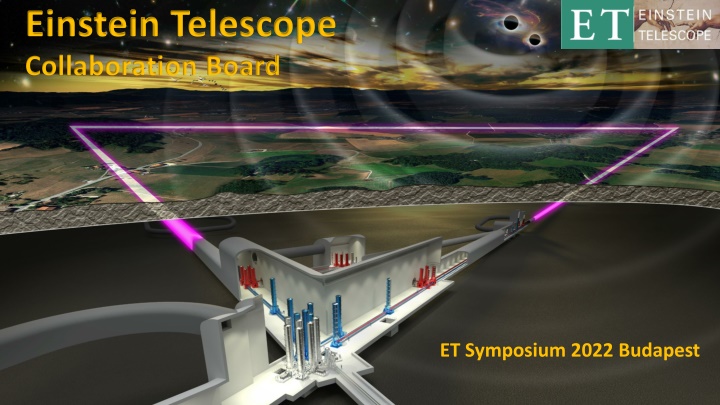

![get⚡[PDF]❤ The Hubble Space Telescope: From Concept to Success (Springer Praxis](/thumb/21514/get-pdf-the-hubble-space-telescope-from-concept-to-success-springer-praxis.jpg)
